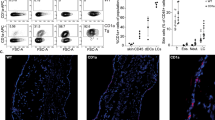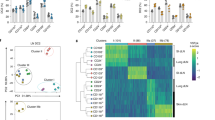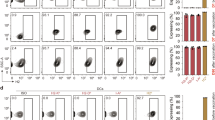Abstract
Aim:
To investigate the effects and underlying mechanisms of 118, a novel derivative of mycophenolic acid, in a murine allogeneic skin graft model.
Methods:
Skin grafts were conducted by grafting BALB/c donor tail skin into C57BL/6 skin beds (allograft) or by grafting female C57BL/6 donor tail skin into female C57BL/6 skin beds (syngraft). The mice were treated with the derivative 118 (40 mg·kg−1·d−1, po) for 13 d (3 d before and 10 d after transplantation). Skin grafts, splenocytes and graft-infiltrated lymphocytes were isolated and examined ex vivo. The effects of the derivative 118 on naive CD4+ T cell differentiation were examined in vitro.
Results:
Treatment with the derivative 118 dramatically increased the survival rate of murine allogeneic skin grafts. Flow cytometric analysis and H&E staining showed that the derivative significantly decreased inflammatory cell infiltration into the grafts. The levels of the chemokines CXCL1, CXCL2, CCL7, and CCL2 were reduced in the derivative 118-treated grafts. Additionally, the derivative 118 significantly suppressed the IL-17 levels in the grafts but did not affect the differentiation of systemic helper T cells in the murine allogeneic skin graft model. Furthermore, IL-23p19 expression was suppressed in the grafts from the derivative 118-treated group, which might be due to decreases in TLR4 and MyD88 expression. Finally, the derivative 118 did not exert direct influences on helper T cell differentiation in vitro.
Conclusion:
Treatment with the mycophenolic acid derivative 118 improves murine allogeneic skin grafts by decreasing IL-23 expression and suppressing local IL-17 secretion in the grafts, rather than directly inhibiting Th17 differentiation.
Similar content being viewed by others
Log in or create a free account to read this content
Gain free access to this article, as well as selected content from this journal and more on nature.com
or
References
Klimczak A, Siemionow M . Immune responses in transplantation: application to composite tissue allograft. Semin Plast Surg 2007; 21: 226–33.
Bardsley-Elliot A, Noble S, Foster RH . Mycophenolate mofetil — A review of its use in the management of solid organ transplantation. Biodrugs 1999; 12: 363–410.
Mathieu P, Carrier M, White M, Pellerin M, Perrault L, Pelletier G, et al. Effect of mycophenolate mofetil in heart transplantation. Can J Surg 2000; 43: 202–6.
Basara N, Blau WI . Efficacy and safety of mycophenolate mofetil for the treatment of acute and chronic GVHD in bone marrow transplant recipient. Transplant Proc 1998; 30: 4087–9.
Ransom JT . Mechanism of action of mycophenolate mofetil. Ther Drug Monit 1995; 17: 681–4.
Allison AC, Eugui EM . Mycophenolate mofetil and its mechanisms of action. Immunopharmacology 2000; 47: 85–118.
Stritesky GL, Yeh N, Kaplan MH . IL-23 promotes maintenance but not commitment to the Th17 lineage. J Immunol 2008; 181: 5948–55.
von Vietinghoff S, Koltsova EK, Mestas J, Diehl CJ, Witztum JL, Ley K . Mycophenolate mofetil decreases atherosclerotic lesion size by depression of aortic T-lymphocyte and interleukin-17-mediated macrophage accumulation. J Am College Cardiol 2011; 57: 2194–204.
von Vietinghoff S, Ouyang H, Ley K . Mycophenolic acid suppresses granulopoiesis by inhibition of interleukin-17 production. Kidney Int 2010; 78: 79–88.
Fuller TF, Hoff U, Rose F, Linde Y, Freise CE, Dragun D, et al. Effect of mycophenolate mofetil on rat kidney grafts with prolonged cold preservation. Kidney Int 2006; 70: 570–7.
Gorbacheva V, Fan R, Li X, Valujskikh A . Interleukin-17 promotes early allograft inflammation. Am J Pathol 2010; 177: 1265–73.
Engl T, Relja B, Natsheh I, Makarevic J, Müller I, Beecken WD, et al. Modulation of the CXC-chemokine expression profile on tumor cells by the immunosuppressive drug mycophenolate mofetil. Int J Mol Med 2005; 15: 641–7.
Loong CC, Hsieh HG, Lui WY, Chen A, Lin CY . Evidence for the early involvement of interleukin 17 in human and experimental renal allograft rejection. J Pathol 2002; 197: 322–32.
Li J, Simeoni E, Fleury S, Dudler J, Fiorini E, Kappenberger L, et al. Gene transfer of soluble interleukin-17 receptor prolongs cardiac allograft survival in a rat model. Eur J Cardio-Thoracic Surgery 2006; 29: 779–83.
Van Raemdonck DE, Verleden GM . The role of interleukin-17 during acute rejection after lung transplantation. Eur Respir 2006; 27: 779–87.
Hou LF, He SJ, Li X, Wan CP, Yang Y, Zhang XH, et al. SM934 treated lupus-prone NZB x NZW F1 mice by enhancing macrophage interleukin-10 production and suppressing pathogenic T cell development. PLoS One 2012; 7: e32424.
Hou LF, He SJ, Li X, Yang Y, He PL, Zhou Y, et al. Oral administration of artemisinin analog SM934 ameliorates lupus syndromes in MRL/lpr mice by inhibiting Th1 and Th17 cell responses. Arthritis Rheum 2011; 63: 2445–55.
Cendales LC, Kirk AD, Moresi JM, Ruiz P, Kleiner DE . Composite tissue allotransplantation: Classification of clinical acute skin rejection. Transplantation 2006; 81: 418–22.
Celli S, Albert ML, Bousso P . Visualizing the innate and adaptive immune responses underlying allograft rejection by two-photon microscopy. Nat Med 2011; 17: 744–9.
Mathur AN, Chang HC, Zisoulis DG, Stritesky GL, Yu Q, O'Malley JT, et al. Stat3 and Stat4 direct development of IL-17-secreting Th cells. J Immunol 2007; 178: 4901–7.
Obata F, Yoshida K, Ohkubo M, Ikeda Y, Taoka Y, Takeuchi Y, et al. Contribution of CD4+ and CD8+ T cells and interferon-gamma to the progress of chronic rejection of kidney allografts: the Th1 response mediates both acute and chronic rejection. Transplant Immunol 2005; 14: 21–5.
Wang S, Li J . Dynamic changes in Th1, Th17, and FoxP3+ T cells in patients with acute cellular rejection after cardiac transplantation. Clin Transplant 2011; 25: E177–86.
Chung BH, Oh HJ, Piao SG, Hwang HS, Sun IO, Choi SR, et al. Clinical significance of the ratio between FOXP3 positive regulatory T cell and interleukin-17 secreting cell in renal allograft biopsies with acute T-cell-mediated rejection. Immunology 2012; 136: 344–51.
Miyamoto M, Prause O, Sjöstrand M, Laan M, Lötvall J, Lindén A . Endogenous IL-17 as a mediator of neutrophil recruitment caused by endotoxin exposure in mouse airways. J Immunol 2003; 170: 4665–72.
Witowski J, Pawlaczyk K, Breborowicz A, Scheuren A, Kuzlan-Pawlaczyk M, Wisniewska J, et al. IL-17 stimulates intraperitoneal neutrophil infiltration through the release of GRO alpha chemokine from mesothelial cells. J Immunol 2000; 165: 5814–21.
Ivanov II, McKenzie BS, Zhou L, Tadokoro CE, Lepelley A, Lafaille JJ, et al. The orphan nuclear receptor RORgammat directs the differentiation program of proinflammatory IL-17+ T helper cells. Cell 2006; 126: 1121–33.
Waibler Z, Kalinke U . TLR-ligand stimulated interleukin-23 subunit expression and assembly is regulated differentially in murine plasmacytoid and myeloid dendritic cells. Mol Immunol 2007; 44: 1483–9.
Goldstein DR, Tesar BM, Akira S, Lakkis FG . Critical role of the Toll-like receptor signal adaptor protein MyD88 in acute allograft rejection. J Clin Invest 2003; 111: 1571–8.
Tang H, Pang S, Wang M, Xiao X, Rong Y, Wang H, et al. TLR4 activation is required for IL-17-induced multiple tissue inflammation and wasting in mice. J Immunol 2010; 185: 2563–9.
Lea NC, Orr SJ, Stoeber K, Williams GH, Lam EW, Ibrahim MA, et al. Commitment point during G0→G1 that controls entry into the cell cycle. Mol Cell Biol 2003; 23: 2351–61.
Acknowledgements
This work was supported by grants from the National Natural Science Foundation of China (NSFC) (Nos 81072652, 81273524, and 81273525).
Author information
Authors and Affiliations
Corresponding authors
Rights and permissions
About this article
Cite this article
Kong, Fy., Chen, W., He, Sj. et al. Mycophenolic acid derivative 118 improves outcome of skin grafts by suppressing IL-17 production. Acta Pharmacol Sin 34, 921–929 (2013). https://doi.org/10.1038/aps.2013.14
Received:
Accepted:
Published:
Issue date:
DOI: https://doi.org/10.1038/aps.2013.14



